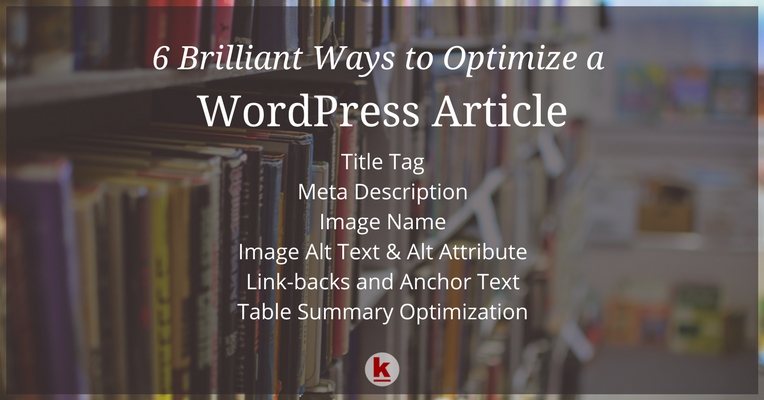
How to Write Perfect Search Engine Optimized Articles in WordPress
It is meaningless to write a post without making it search engine friendly on any platform, whether it’s WordPress or your companies CMS. It’s time to understand why search engine optimized pages get more traffic.
If you are a webmaster you need to know how you can make your content Search Engine Optimized in order to get a better ranking on search engine result pages.
WordPress SEO Article
SEO specialists are experts and are aware of the valid and latest SEO algorithms. Moreover, for a web page, each and every post has some ranking based upon the quality of content and usage of specific keywords. Are you working writing WordPress articles? Don’t miss out on these points before you write another article on WordPress!
Title Tag
The Title tag is a short descriptive phrase used to describe the content of a web page. It is one of the most important factors in achieving a high ranking for your website or webpage on Google. The presence of important and relevant keywords in the title tag is the first and most important indication to search engines on how to identify and classify the page and its relevance to a specific topic.
Meta Description
Meta Description tag is an HTML code which carries a short description about the content of the page. Meta description tags contribute to the search engine result page ranking. If the search keywords are present in the Meta description tag, then the search engines use the content of this tag in the SERPs. If the searched keywords are not present in the Meta description tag, then the search engine constructs snippets of the text on the page, which contain and surround the search terms.You get about 25 –
You get about 25 – 30 word limit to add your keywords in the Meta Description tag and create a description that can grab readers attention. Google sees every blog post as a different web page so you can rank every post for certain keywords.
Image Name
Spiders can’t read images. Image file names help Google bots to recognize an image. The Image name is simply the filename of the picture or graphic visible on the web page. Image file name optimization helps in search engine optimization. However, optimized file names can play a greater role for image search engines. For example – if we use “image123456.jpg” as a name for an image of an apple, it does not give a clue to the users (or search engines) about the nature of the image. However, renaming the file to “apple.jpg” will help users, as well as the search engine spiders to identify and classify the image a lot better. It is good SEO practice to have keyword-specific file names of all images wherever relevant and possible.
Image Alt Text & Alt Attribute
Image Alt Text helps a search engine understand what an image is about. The alternate text of an image helps in case images on a page cannot be loaded. Users and search engines classify an image based on this alt text. If the image is hyperlinked to another page, then you can also specify an image Alt Attribute with keywords describing the content of the target page. This helps the search engines classify the target page in their index better.
Link-backs and Anchor Text
In a website, Anchor Text is used to build relevance of the target page. Repeated use of relevant keywords within the Anchor Text on various pages of a website tell the search engines about the target pages theme and helps it classify the target page better. For example, the text “SEO case studies” within the Anchor Text, indicates to visitors that they can expect to see content about “SEO case studies” if they visit the link. This pattern of usage has been applied in search engine algorithms to enhance the relevance of the “target” or the “landing page” for the keywords appearing within the Anchor Text.
When writing a new post, try to link back to old blog posts so that readers will stick around your site for longer and also so that search engines can re-crawl these old posts.
Table Summary Optimization
Table summary element optimization plays a small but incremental role in improving rankings on search engine result pages. The table summary provides web crawlers and screen readers with alternative text for the content and structure of the table. For web crawlers, this means that instead of seeing a graphic, the crawler sees your description, in which you can include keywords if they are appropriate and relevant to the content of the table.
To summarize, understand that there are a lot of competitors for your product or service. Every bit of the effort you do to optimize your page for important keywords helps you rank higher on search engines. Don’t leave any opportunity for inching your page towards higher ranking and pulling the right traffic to your website. Be patient while working on SEO as these ranking Algorithms go through a lot of fluctuations, which push us to work on Google testing every now and then. It’s possible that some of the things they changed could come back as well. Hence, the quality of content is a major requirement for SEO.
Have additional thoughts you’d like to contribute? Submit a guest post on the RedAlkemi blog!
